Untitled Document
 It’s that time of year where the driving wind/rain and low temperatures expose the ‘leakier’ and more vulnerable parts of our buildings.
It’s that time of year where the driving wind/rain and low temperatures expose the ‘leakier’ and more vulnerable parts of our buildings.
The summer heat can mask a problem, enabling the fabric of a roof or wall to dry in-between downpours, but come autumn, the materials become more and more saturated leading to a dreaded ‘drip'.
Gutters and drains can become blocked by leaf fall and blown debris, as a consequence rain water can be diverted into areas that really don’t want it! Add into that, frozen pipes and the complications of older buildings and autumn and winter can be a headache.
Although it is always best to solve the problem at source, sometimes building design, even at a well-maintained property, allows water ingress in certain conditions. Making a repair is often incredibly expensive or incredibly difficult. So, what can you do? | >Skip to the table of absorbent materials
Do you already have a damp problem?
 High levels of humidity can be an indication of water ingress (but not always). Mould, and resultant insect infestations, can be results of unchecked and unmanaged environments and wreak havoc on collections (read our blog about mould here).
High levels of humidity can be an indication of water ingress (but not always). Mould, and resultant insect infestations, can be results of unchecked and unmanaged environments and wreak havoc on collections (read our blog about mould here).
It’s important to monitor these at all times, especially in older buildings, even if you are not aware of any previous problems. Inspect drains and gutters for blockages and monitor roofs and chimney stacks. Heating and dehumidifiers can be used to reduce RH and humidity respectively, but the source of excess humidity should be established. Sometimes ventilation is all that is required to prevent excess humidity. As a simple example, blocked air bricks in buildings with suspended floors can lead to increased humidity inside the building. Remote data loggers, accessible via the internet are ideal for monitoring buildings, particularly if they are not open and monitored regularly. The Easylog wifi data loggers are accessible via the cloud for remote data viewing, click here to view the EasyLog WiFi monitors.
Extensive monitoring work was performed at the National Trust site of Blickling Hall in Norfolk UK to establish the impact of climate change on historic buildings as part of the PARNASSUS project. Blickling had historically suffered some mould and insect infestation issues as a result of high humidity, to which much effort has been invested to solve. The project monitored a number of factors including wind speed, direction, rain-fall, and more to establish recommendations for reduction in internal humidity. You can read the full report here. It shows that resolutions to problems exist both within and outside of the building.
 Be prepared
Be prepared
A leak can be stressful at any time, but when charged with the care of a collection it’s important to have a plan in-place. In small buildings, it’s easier to assess the potential risks posed and prepare accordingly (e.g. frozen pipes, broken tiles etc), for larger institutions a more wholistic approach to ‘disaster preparedness’ is essential. BS ISO 21110:2019 sets out the standard for ‘Emergency preparedness and response’ for archives, libraries and museums.
Your plan will be specific to the building and objects or works of art stored or displayed within it, and having procedures in-place will assist the recovery in the event of a disaster. This will require rehearsal, and responsibilities should be clearly assigned to any team members.
The Collections Trust offer a template disaster plan here which you might find useful.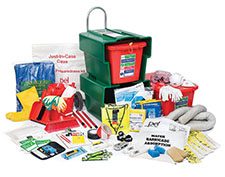
The ‘Just-in-case case’ (pictured with contents, right) and ‘Just-in-case pack’ are affordable disaster preparedness kits that offer a wide range of absorbent and clean up items and are designed for institutions. These kits include most (if not all) things you’d need to contain and recover a situation. For water ingress see our table of absorbent materials below.
Flooding, leaks, and how to deal with them
According to
environmental studies carried out by the University of East Anglia, rainfall in the UK has increased over the last 100 years, especially during the winter, and this is ‘consistent with scenarios of man-made climate change’. The same report also concludes that ‘a trend towards larger rainfall totals during the winter’ and ‘an increase in the intensity of precipitation (especially during winter)’ is also likely.
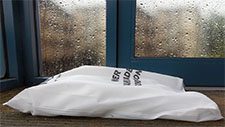
There is an increased likelihood, especially in the UK, that we will experience an more and more extreme weather events. Preparing for heavy rainfall and floods in vulnerable buildings in will become increasingly important.
If you are at risk of flooding it’s important to have suitable absorbent materials easily accessible, these may simply be used to stem a flow or may be sufficient to deal with smaller floods and leaks. Remember water may be coming from above (i.e. a leaking roof) or from beneath (in the event of a flood).
There are a number of different types of absorbent products to suit varying levels and types of risk or water ingress. Our chart below gives you some idea of the kinds of ingress each absorbent product is suitable for and how much water they can absorb.You can build your own kit from the following based upon the risks posed in your building:
Fluid capacities of absorbent products
| Product code |
Description |
Each Unit Fluid Capacity |
Number in Pack |
Total pack fluid capacity |
Image |
377-5003
View here
|
Absorbent pads 400mm x 500mm. Ideal for smaller volume leaks in a large area or to complement other cushions or snakes. |
1 litre |
100 pads
One pack can cover 20sq metres. |
100 Litres |
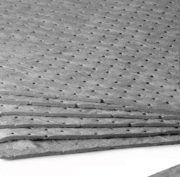 |
377-3023
View Here
|
Absorbent Strips (105mm wide) - Ideal for window sills, under doors, under furniture, radiators and other tight spaces. Smaller leaks. Integral warning pattern and saturation indicator.
|
2 Litres |
50 x 600mm strips (30 metres in total) |
100 Litres |
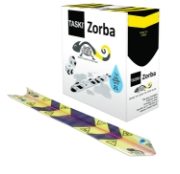 |
377-3022
View Here
|
Absorbent Snakes ideal for leaks at doorways or windows where strips are not sufficient. 1200mm long. Use together with pads in larger leaks. |
6 litres |
20 snakes (24 metres in total length) |
120 litres |
 |
377-3007
View Here
|
Absorbent Cushion for larger leaks floods and flood protection. Saturated cushions can be used like a sand bag. 570mm x 420mm x 5mm |
20 Litres |
1 Cushion |
20 Litres |
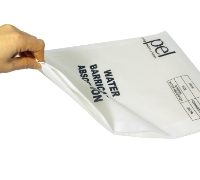 |
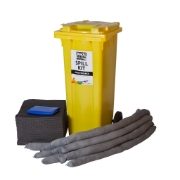 Spill kits are also available for larger institutions in 50 litre, 120 litre and 240 litre capacities, all include transport vessel (bag or wheeled bin) and disposal bags.
Spill kits are also available for larger institutions in 50 litre, 120 litre and 240 litre capacities, all include transport vessel (bag or wheeled bin) and disposal bags.
Review your plan
If you have had an incident it’s important to debrief and review procedures to; ensure that the current plan is sufficient, to ensure any items used from your kits have been replenished, that any contact names or numbers are still current, that no significant changes in the building design or layout will affect current plans.